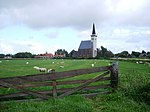De Waal
North Holland geography stubsPopulated places in North HollandTexel

De Waal is a village in the Dutch province of North Holland. It is a part of the municipality of Texel, and lies about 15 km north of Den Helder. The village was first mentioned in 1295 as "sancti Bonifacii in Waelkerken", and means "pond created after a dike breach". De Waal started to developed after the Waalenburg polder was created in 1436. The Dutch Reformed church is built on a terp (artificial hill). It was destroyed in 1945 during the Georgian uprising. A new church was built in 1952 and a tower was added in 1961.
Excerpt from the Wikipedia article De Waal (License: CC BY-SA 3.0, Authors, Images).De Waal
Tienhoven, Texel
Geographical coordinates (GPS) Address Nearby Places Show on map
Geographical coordinates (GPS)
| Latitude | Longitude |
|---|---|
| N 53.066666666667 ° | E 4.8166666666667 ° |
Address
Tienhoven
Tienhoven
1793 EC Texel
North Holland, Netherlands
Open on Google Maps









